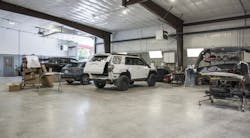There's a feeling that shop owners sometimes get: "Is my shop doing enough?" They look around the shop some days and see a capacity for more work, while other days they can't handle the workload they currently have. Helping turn feelings into results is where David McCreight comes in.
“People say, 'Well, I always thought I could do more because I knew, like, benchmarks or whatever would tell me I should be able to,'” says McCreight, owner and president of Collision Resources Inc., a provider of scheduling and estimating software and consulting services. “'But I never could figure out how to do it; we tried more employees, we tried different pay plans.' And it comes back to how you load the shop, the mix of work that you load in the shop, and then just managing that work in process as it goes through the flow.”
McCreight sought to solve this problem through software, and it's generated positive results for many, many customers. In that process, he's identified numerous pitfalls that shops run into when it comes to scheduling work, working efficiently, and increasing revenue.
The Backstory
Anyone who has been around collision repair for a while knows the standard operating procedure when it comes to scheduling work: Take it in on Monday, send it out by Friday. Shops 25 years ago used computers, if for nothing else but estimating, but scheduling was done on desk calendars. It was filling in jobs in blank spaces on a sheet.
Shops were scheduling employees based on the number of jobs but not really considering the number of hours in a job. This was before many large consolidators and MSOs had entered the market and pooled their resources to learn from data across many locations. So, while it made logical sense to load up the shop on a Monday and get all the work out in a workweek, reality showed this was an inefficient process. Then a business development manager with AkzoNobel, McCreight began noticing where shops were failing in scheduling.
“They were actually adversely affecting the number of vehicles that were tied up over the weekend,” McCreight says. “Because once we leveled that schedule out, we saw the number of cars tied up over the weekend went down by a third. Because what was happening was the cars were coming in on Monday, yet they were sitting until Wednesday or Thursday before they were touching them.”
The Problem
As McCreight observed, shops were scheduling work more in theory than reality. Their capacity was full, but it didn't mean work was getting done. The scheduling didn't actually line up with how work was assigned.
“The body technicians, a lot of times, were just going to the parking lot and picking the cars that they wanted to work on,” recalls McCreight. “So, they were looking for the gravy, or they were looking for maybe a really big job where they could make good time on them. So, it wasn't necessarily focused on what was good for the customer. It was what was good for the technician. There wasn't any process there to assign work.”
Even though times have changed and modern shops have access to all sorts of resources for solving scheduling and workflow inefficiencies — including software solutions like McCreight's — many shops are still setting themselves up for failure. McCreight identifies a few areas in which shops can improve their workflow, such as scheduling the right mix of work, moving to a visual production process, and identifying bottlenecks in the shop.
A shop's work in process (WIP) is, as the name implies, a measure of the amount of work in hours that a shop is currently engaged in. Sometimes shop experience delays, for myriad reasons, and when technicians need something to do, the impulse is to add more work. But too much work quickly adds up, and stacks up, and craters cycle time.
The Solution
McCreight came out with the first version of his software in 2002, featuring a patented algorithm that has continued to evolve over time. McCreight is a Lean Six Sigma black belt and certified business coach, which has informed his approach to these solutions. But it doesn't take a detailed business audit to make process improvements. The path to greater efficiency is all about finding the sweet spot of your WIP where productivity is maximized and not overtaxed.
“You don't want to have one car on-site,” McCreight says as an example, “because if you have one car, what are the other people going to work on? So, one car is not the right number and if you're doing 50 cars a month, having 100 cars on site at any one time, you've got way too many cars on site. So somewhere between one and 100, you're going to cross two lines (as on a graph) and you're going to be somewhere in this target range.”
McCreight's software can help make these sorts of calculations automatically. But in the beginning, he did it manually with an Excel spreadsheet and a value-stream map. And that revealed that taking in the proper mix of work was important — not all jobs are created equally, and shops need less severe repairs mixed in to fill gaps and operate at peak efficiency.
Scheduling software can also give a visual impression of the repair process that’s easy for everyone to see. Say there are more cars waiting than there are technicians available to work.
“There's an imbalance there, so it's identifying, again, where the waste is in the system,” McCreight says. “And then it becomes visual. Everybody can see it, because it's something that's shared with the entire team. They put it on the big screen TVs, and so it becomes visual.”
The Takeaway
McCreight’s system has produced some impressive results. In addition to reducing the percentage of cars held over a weekend by 33%, he also claims an increase in hours produced by repair order by 31% and a reduction in cycle time by two whole days.
“You show (shop customers) the numbers, show them what's happening in their store,” says McCreight. “You show them what they were doing prior to using the program to after using the program, and they're always able to produce more hours, more vehicles, but the stress level goes down. They're producing more work with the same number of people, the same square footage.”
Often, the key to success is actually reducing the number of cars a shop takes on in a day. The reason is simple; the cost of taking on just one extra car could cause a chain reaction that backs up cycle time. Interrogating where the bottlenecks are occurring in a shop is important to finding that sweet spot.
“Anytime you reduce — if you can — the number of vehicles on-site by one and still maintain the same production capacity, you've improved your cycle time,” says McCreight.
The Aftermath
Identifying where these bottlenecks are often means a change in processes. It might mean taking on a new software system, and these changes are never easy. So, in addition to tightening up the repair process, it’s also important to be a good manager of change. Shop owners should take care to figure out the best way their employees are going to engage with new information and what the best way is for them to learn.
“Change management, getting your team on board, it can't just be that you go to a 20 group and you bring back an idea, work on it for two weeks, and it just goes away,” says McCreight. “Your employees get used to that, and change management becomes really hard because they just regress back to what they've always done.”
About the Author
Todd Kortemeier
Todd Kortemeier is former editor of FenderBender magazine and started writing as a contributor in 2024.

